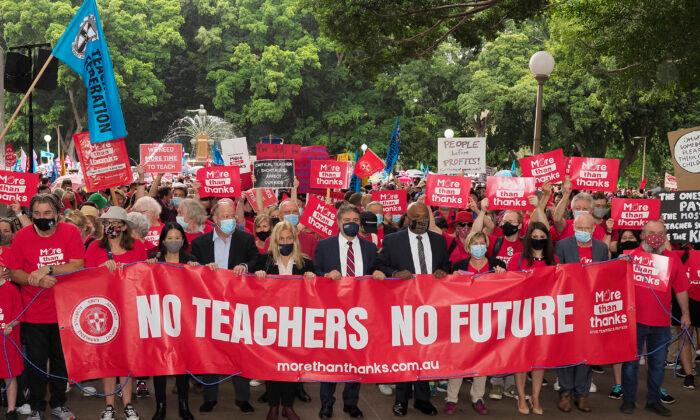Public school teachers and principals in New South Wales (NSW) have walked off the job for 24 hours over workloads and salaries and the staff shortages they result in.
According to the NSW Teachers Federation figures, more than 15,000 teachers gathered at Sydney’s Hyde Park and marched towards the state parliament house on Macquarie Street. Protests were also held around the state.
Federation President Angelo Gavrielatos said tens of thousands of teachers across the state had participated in the first 24-hour stoppage in a decade. Thousands of schools were also closed as a result.
Gavrielatos said the union had “exhausted all options” over its 18-month negotiation period with the government before resorting to industrial action.
The union is fighting to raise the wages cap to 5 percent and give teachers more preparation time for the classroom.
“The idea that a 10-year wages cap is an appropriate response to teacher shortages, rising student enrolments, and a 30 percent decline in the number of people studying teaching is beyond comprehension,” he said.

“Teacher shortages exist because other professions pay better and the workloads are lower,” he said
NSW Department of Education Secretary Georgina Harrisson said they had worked to ensure that learning could continue without disruption and understood the frustration of families after a difficult year for many parents and carers.
“The department has called on the Federation and its members to comply with the Industrial Relations Commission’s order and not strike, but this has been unsuccessful,” Harrison said on Dec. 6.
She said the department was working to implement a four-year plan to address future teacher supply needs.
“There are more teachers employed in our schools than ever before, and we are working on a number of initiatives to deliver a sustainable supply of quality teachers, particularly in critical subjects and in locations that are challenging to fill,” she said.
She also noted that the 2.5 percent wages increase was the maximum amount allowed per annum under the Industrial Relations Act.
However, NSW Greens state MP David Shoebridge has said the offer was not good enough.
He called on the government to consider that NSW teachers have had their pay frozen for 10 years.





